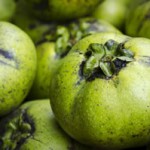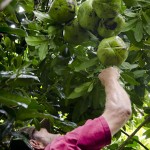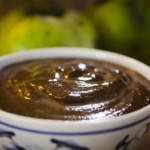Cultivating ‘Chocolate Fruit’
Hula Daze Farm grows tropical fruit on 10 acres using organic techniques such as insect pest management. David Whatmore has been growing fruit on Kaua’i since 1987. He and wife Maria sell the fruit at eight markets across the island.
What’s growing now: Acerola cherry, aloe vera, apple banana, avocado, black sapote, chico sapote, caimito (cream apple), durian, eggfruit, grapefruit (white, low-acid), jackfruit, Jamaican lilikoi, Java plum, jaboticaba, langsat, limes, longan, lychee, mabolo, mango, mangosteen, mountain apple, papaya, pedalai, soursop (fiberless), red mombin, star fruit, strawberry guava, tangelo, tangerines (seedless), white sapote
BLACK SAPOTE
Sapote in Spanish-speaking countries means soft fruit. Sapote Negro, or black fruit, is native along both coasts of Mexico. The color of the flesh runs between chocolate brown to jet-black. Its rich, silky texture and mild chocolate flavor inspire the nickname “chocolate pudding fruit.” The flesh is like uncooked brownie batter, only not as sweet.
If you have tried black sapote, also known as black persimmon, it’s likely that you are addicted to the custard-like fruit that tastes somewhat like chocolate. For those of you who haven’t tried it, you’ll probably have to call on your courage, get over the look of it and try some. After trying a sample, it’s my new favorite fruit.
“In Mexico, the best gift you can give somebody is the black sapote,” says David. “If you really want to honor somebody, and give them something that they covet, it’s black sapote.”
Season: “We have harvested them at any time of the year,” says David. “But this year, most of them went off in March and April.” He expects to have them throughout May and possibly into June.
What to look for: “When they’re ripe enough to eat, they’re supposed to be marshmallow-soft,” says David. “Most people say, ‘Oh! That’s mushy!’ But that’s how they’re supposed to be.”
Storage: Unripe black sapote may or may not ripen if left sitting on a plate, on the counter, out of sunlight. “I’ve had one sitting on a table for four months before it ripened,” says David. “Sometimes, when they take that long, they’re no good. But sometimes they’re really good.”
They can ripen quickly, so check daily. Ripe fruit will store in the refrigerator for months. “They’re the best storing of all the tropical fruits,” says David. “We had one in the refrigerator for three months!”
Pack pulp into moisture-and vapor-proof containers, leaving a half-inch head-space, and freeze for later use.
Preparation: According to Purdue University, in the Philippines the seeded pulp is served as dessert with a little milk or orange juice. The addition of lemon or lime juice makes the pulp desirable as a filling for pies and other pastry. It also is made into ice cream. In Mexico, the pulp may be mashed, beaten or passed through a colander and mixed with orange juice or brandy, and then served with or without whipped cream. Also, they sometimes mix the pulp with wine, cinnamon and sugar, and serve as dessert. Some Floridians blend the pulp with milk and ground nutmeg. A foamy, delicious beverage is made by mixing the pulp with pineapple juice in a blender. In Central America, the fermented fruit is made into a liqueur somewhat like brandy.
Tip: Unripe fruit is a very astringent irritant, caustic and bitter. It has been used as fish poisoning in the Philippines.
Health benefits: It’s surprising that a fruit this rich is low in fat. One hundred grams is 130 calories, and contains 0.01 grams of fat, 2 grams of protein, 20 milligrams of vitamin C, 345 milligrams potassium, and 400 IU of vitamin A.
Hula Daze Farm produce can be found at: Farmers Markets: Namahana (Saturdays, 9 a.m.), Hanalei (Saturdays, 9:30 a.m.), Koloa (Mondays at noon), Waipa (Tuesdays, 2 p.m.), Kapa’a (Wednesdays, 3 p.m.), Kilauea (Thursdays, 4:30 p.m.), Vidinha Stadium (Fridays, 3 p.m.).
For more information on Hawaii’s tropical fruit, visit HTFG.org.
BLACK SAPOTE PUDDING
I adapted this recipe from the Tropical Fruit Cookbook by Marilyn Rittenhouse Harris. You don’t have to strain the pulp, but I think it looks prettier. This uncooked “pudding” is smooth, chocolatey and cool, with a nice vanilla flavor.
* 1 black sapote
* 1 tablespoon sugar
* 2 teaspoons vanilla extract
* 2 teaspoons cocoa powder
* 1/3 cup milk
Set strainer over a medium-size bowl. Cut fruit in half, remove the seeds from the fruit and scoop pulp into strainer. Using a flexible spatula, press the pulp through the strainer and into the bowl.
Whisk in remaining ingredients, cover with plastic wrap and chill. Spoon into two bowls and serve.
Makes two servings.
- Maria Whatmore
- David Whatmore with a 3-pound black sapote
- The trees grow up to 80 feet
- Black sapote is closely related to the persimmon. Daniel Lane photos
- Harvesting ripe fruit
- Black sapote tastes better than it looks!
- Black sapote pudding. Daniel Lane photos










